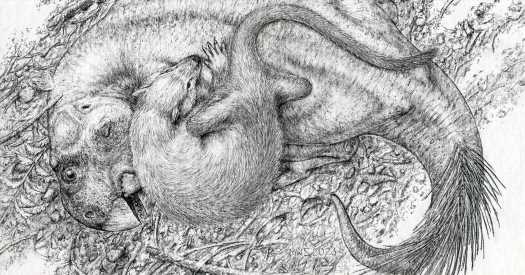
The work of a paleontologist is often like solving a puzzle with no picture on the box and most of the pieces missing. From scattered bones and teeth, scientists studying fossils extrapolate entire long-dead creatures, and even relationships between different species. But every so often, researchers get a lucky break in the form of nearly complete skeletons, their bodies preserved in a way that offers a glimpse into their behavior in life.
This could be the case with a newly described fossil of a badger-like mammal and a Labrador retriever-sized dinosaur, locked in what appears to be an eternal brawl. A mixed team of Canadian and Chinese researchers published their findings in the journal Scientific Reports on Tuesday, along with a section of the study devoted to addressing concerns that the fossil is a fake.
The prehistoric skirmish took place around 125 million years ago, in what’s now northeastern China, and appears to be something like a man-bites-dog story of the dinosaur era. Usually in that period, conventional wisdom holds, mammals were meek, eking out a tenuous existence as terrible reptiles shook the ground around them. But the unlikely fossil depicts combat between a mammal called Repenomamus robustus and a bipedal, plant-eating relative of Triceratops called Psittacosaurus lujiatunensis.
Size-wise, the dinosaur had an advantage, but Repenomamus, preserved with its teeth clamped into Psittacosaurus’s rib cage, appears to have punched above its weight. The dinosaur’s bones don’t show evidence of being gnawed on by scavengers, indicating that the Repenomamus encounter happened when the Psittacosaurus was still alive.
“There are examples today of small carnivorous mammals taking down much, much larger prey,” said Jordan Mallon, a paleontologist at the Canadian Museum of Nature and a co-author of the study. He pointed to wolverines taking down caribou. He added, “We think Repenomamus was probably similarly a small, feisty predator that was willing to take down prey that was much larger than itself if it had to.”
The animals’ preservation mid-melee required a great deal of luck (or unluckiness, from the animals’ point of view). It started with a volcanic eruption, unleashing ash. That ash could have been converted into a mudslide by seasonal flooding or heavy rains. Then, while this Repenomamus and Psittacosaurus were fighting, “this mud flow sort of caught them off guard and preserved them for 125 million years,” Dr. Mallon said.
The fossil was unearthed in 2012 by farmers in the Chinese province of Liaoning and acquired by Gang Han of the Hainan Vocational University of Science and Technology, a co-author of the study. The find was incredible, and there are numerous cases when such discoveries have turned out too good to be true. Fossil forgeries, including separate specimens being put together to complete a skeleton or a scene, are “a big problem,” Dr. Mallon said. “This was a concern that we had, and so we had to do our homework to at least convince ourselves” that it was legitimate.
Dr. Mallon said that the researchers dug into the rock surrounding the fossils and found that the mammal’s left lower jaw “was indeed plunging into the rock and was indeed biting the ribs of the dinosaur,” rather than simply being placed together by a fossil forger. The researchers also analyzed the rock in the fossil and rock from the fossil beds where it was purportedly found; they matched. Based on these independent lines of evidence, “we feel fairly satisfied that this is a genuine fossil and it is not a fake,” Dr. Mallon said.
Or if it’s a fake, he said, it’s “the best I’ve ever seen.”
David Grossnickle, an evolutionary biologist at the University of Washington who also was not involved with the study, said that while in the “worst-case scenario,” parts of the fossil specimen might have been forged, the mammal skull biting into the dinosaur bone appears to be real, and that piece alone is “still an incredible fossil.”
If no convincing challenge to its authenticity is presented, the fossil offers tantalizing evidence of how mammals and dinosaurs interacted.
“We rely on spectacular fossils like this to really fill in the gaps of how these ancient ecosystems work, because we can’t always rely on just the bones alone to tell us these stories,” Dr. Mallon said.
Michael Pittman, a paleontologist at the Chinese University of Hong Kong who was not involved with the study said that the immortalized bite didn’t necessarily mean that Repenomamus was hunting down dinosaurs for food and that the animals might have been engaged in less of a predatory takedown and more of a “scuffle.”
But the study may contribute to the “growing evidence that Mesozoic mammals were more ecologically diverse than we classically thought,” Dr. Grossnickle said, “and getting a little bit of revenge, I guess, on those big mean dinosaurs.”
Source: Read Full Article